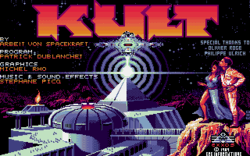KULT: The Temple of Flying Saucers
| KULT: The Temple of Flying Saucers | |
|---|---|
 Title screen (Amiga) | |
| Developer(s) | Exxos, ERE informatique |
| Publisher(s) | Infogrames, Data East Corporation (US) |
| Director(s) | Johan Robson (as Arbeit von Spacekraft) |
| Designer(s) | Johan Robson |
| Programmer(s) | Patrick Dublanchet |
| Artist(s) | Michel Rho |
| Writer(s) | Johan Robson |
| Composer(s) | Stéphane Picq |
| Platform(s) | Amiga, Atari ST, DOS |
| Release | 1989 |
| Genre(s) | Adventure, puzzle |
| Mode(s) | Single player |
KULT: The Temple of Flying Saucers is a graphic adventure game, released in 1989 by Exxos. The American version was sold under the title Chamber of the Sci-Mutant Priestess.
Setting
The game is set in a post-apocalyptic environment. Society consists of two races: Tuner; who possess psy-powers and Protozorqs; who are physical mutants.
Raven, a Tuner, is caught prisoner in the temple of the Protozorqs, and must find his girlfriend, who was also kidnapped, to finally proceed to escape with her. Raven is aware that his quest won't be simple since the Protozorqs, armed with "zapsticks", will gladly kill him if he does anything they dislike.
Technical characteristics

The game featured a unique point-and-click interface with 2D screens where the main character was not visible; objects and characters displayed contextual menus when clicked on.
Versions of the game released for different platforms:
- The Amiga version had OCS graphics, digitized sound effects, and a distinctive opening tune, which is sampled here.
- The PC version, which was for DOS, had either 16-color EGA or Tandy-compatible graphics, 4-color CGA graphics, or 2-color Hercules graphics. Sound effects were PC speaker beeps or Tandy 3-voice music with a continuous background music loop during the game.
Reception
Computer Gaming World called the game "an imaginative adventure game" with unusually good graphics and audio. It recommended the game to fans of adventures with puzzles, with the story's short length and abrupt ending the main faults.[1]
References
- ↑ Greenberg, Allen (July–August 1990). "Boy Gets Girl / Data East's "Chamber of the Sci-Mutant Priestess"". Computer Gaming World. p. 35. Retrieved 16 November 2013.